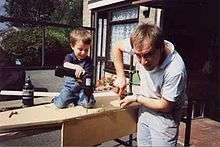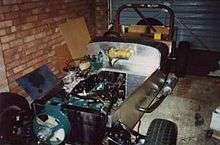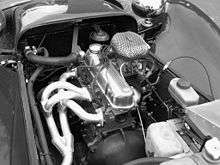Locust (car)




Locust is a kit car inspired by the Lotus Seven.
History
The Locust Seven used a ladder frame and a body constructed from three 8 ft by 4 ft sheets of 3/4" thick exterior grade or marine plywood alternatively MDF sheets. Once complete, the body tub is skinned with aluminium sheet.
The original design was by John Cowperthwaite and it was sold as the JC Locust by J.C. Auto Patterns.[1] Later, the production rights was taken over by T&J Sportscars who also introduced a Ford Cortina-based version called the Hornet. It was then taken over by White Rose Vehicles (WRV) who developed the Locust into Locust ES and also introduced the Ford Sierra-based Locust SIII. In April 2000 the Locust ES was taken over by BWE Sportcars who also made the Hornet[2] and the Grasshopper electric car for children.[3] The Sierra-based Series III was taken over by Road Tech Engineering. Bev Evans of BWE died on 10 April 2014. BWE Sportscars is no longer trading.
See also
- Locost - a similar concept to the Locust, but with a welded space frame chassis
References
Further reading
- Ortenburger, Dennis. Lotus Seven & The Independents. ISBN 1-902351-12-6.